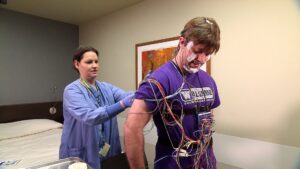When a Patient Requires a Polysomnography Test in Delhi?
When a Patient requires a Polysomnography test in Delhi . Conjointly referred to as a sleep study, maybe a comprehensive take look at the  accustomed diagnosis of sleep disorders. Polysomnography test in Delhi records your brain waves, the gas level in your blood, vital sign and respiration, similarly to eye and leg movements throughout the study.
accustomed diagnosis of sleep disorders. Polysomnography test in Delhi records your brain waves, the gas level in your blood, vital sign and respiration, similarly to eye and leg movements throughout the study.
Polysomnography is also done at a sleep disorders unit in a hospital or a sleep centre. whereas it’s generally performed in the dark, polysomnography test in Delhi is often done throughout the day to accommodate shift staff who routinely sleep throughout the day.
In addition to serving to diagnose sleep disorders, the polysomnography test in Delhi is also accustomed to facilitating initiating or modifying your treatment arrangement if you have already been diagnosed with an upset.
 Why You Need a Polysomnography test
Why You Need a Polysomnography test
Polysomnography monitors your sleep stages and cycles to spot if or once your sleep patterns area unit noncontinuous and why.
There are different types of home apnea take a look at devices utilizing distinct combos of sensors. they typically record your respiration rate and airflow, similarly to gas levels and vital signs. One vogue conjointly incorporates info on blood vessel tone.
The typical way of falling asleep begins with a sleep stage called non-rapid eye movement (NREM) sleep. throughout this stage, your brain waves, as recorded by electroencephalography (EEG), block significantly.
Your eyes do not withdraw and forth speedily throughout nonrapid eye movement sleep, in distinction to later stages of sleep. when an hour or 2 of nonrapid eye movement sleep, your brain activity picks up once more, and speedy eye movement (REM) sleep begins. Most dreaming happens throughout rapid eye movement sleep.
You commonly bear multiple sleep cycles a night, athletics between orthodox sleep and rapid eye movement sleep in concerning ninety minutes.
Your doctor could suggest polysomnography if he or she suspects you have:
1.Sleep apnea or another sleep-related respiration disorder.
In this, your respiration often stops and starts throughout sleep.
2.Periodic limb movement disorder.
During this upset, you involuntarily flex and extend your legs while sleeping. And this condition is linked with restless legs syndrome.
3.Narcolepsy
Your expertise overwhelming daytime temporary state and unforeseen attacks of sleep during this condition.
4.REM sleep behaviour disorder
Unusual behaviours throughout sleep. Your doctor could perform this take a look at if you are doing uncommon activities throughout sleep, like walking, travelling tons or beating movements.
5.Unexplained chronic sleep disorder
If you systematically have hassle falling asleep or staying asleep, your doctor could suggest polysomnography.
After you prepare for bed, one in every one of the technologists can place sensors on your scalp, temples, chest and legs employing a delicate adhesive, like glue or tape. The sensors area unit is connected by wires to a laptop, even so, the wires are long enough to allow you to move around in bed. A tiny low clip is also placed on your finger or ear to watch the extent of gas in your blood.
While you sleep, it monitors your:
- Brain waves
- Eye movements
- Heart rate
- Breathing pattern
- Blood oxygen level
- Body position
- Chest and abdominal movement
- Limb movement
- Snoring and alternative noise you will build as you sleep
 In the Polysomnography test in Delhi technologists monitor you throughout the night. If you would like help, you’ll seek advice from them through the observation instrumentation. they will acquire the area to release the wires if you would like to urge up throughout the night.
In the Polysomnography test in Delhi technologists monitor you throughout the night. If you would like help, you’ll seek advice from them through the observation instrumentation. they will acquire the area to release the wires if you would like to urge up throughout the night.
During the Polysomnography test in Delhi, the soul could have ever strivedfor a positive airway pressure (PAP) machine for apnea. this is often a tool that consists of a tight-sealing nosepiece through that a delicate stream of air is delivered to reinforce your respiration.
The measurements recorded throughout the Polysomnography test in Delhi give an excellent deal of data concerning your sleep patterns. For example:
Brain waves and eye movements throughout sleep will facilitate your health care team to assess your sleep stages and determine disruptions within the stages which will occur because of sleep disorders like hypersomnia and rapid eye movement sleep behaviour disorder.
The information gathered. Then that info is reviewed by your sleep centre doctor.